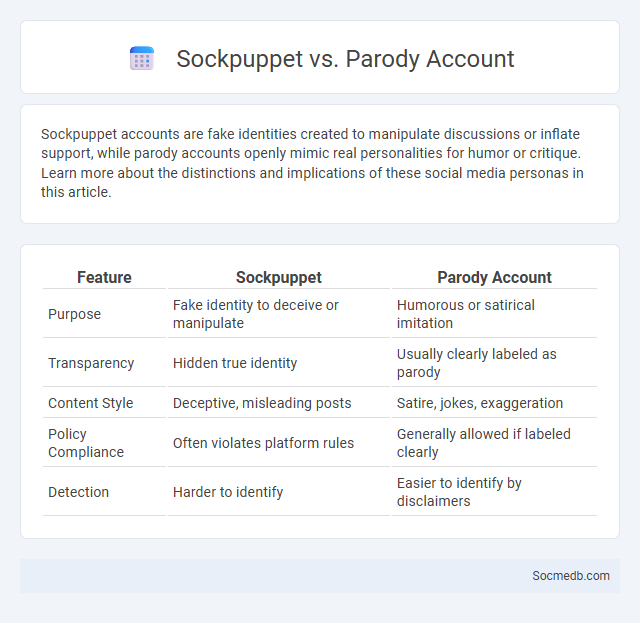
Photo illustration: Sockpuppet vs Parody Account
Sockpuppet accounts are fake identities created to manipulate discussions or inflate support, while parody accounts openly mimic real personalities for humor or critique. Learn more about the distinctions and implications of these social media personas in this article.
Table of Comparison
| Feature | Sockpuppet | Parody Account |
|---|---|---|
| Purpose | Fake identity to deceive or manipulate | Humorous or satirical imitation |
| Transparency | Hidden true identity | Usually clearly labeled as parody |
| Content Style | Deceptive, misleading posts | Satire, jokes, exaggeration |
| Policy Compliance | Often violates platform rules | Generally allowed if labeled clearly |
| Detection | Harder to identify | Easier to identify by disclaimers |
Introduction to Online Identities
Online identities shape how you present yourself and interact on social media platforms, influencing personal branding and digital reputation. These virtual personas are crafted through profile information, shared content, and engagement patterns, reflecting your interests and values. Understanding the dynamics of online identities helps manage privacy and fosters authentic connections in the digital landscape.
What is a Sockpuppet Account?
A sockpuppet account is a fake online identity created to manipulate public opinion or deceive others on social media platforms. These accounts often post misleading comments, support certain views artificially, or circumvent bans and restrictions. Social media networks actively monitor and remove sockpuppet accounts to maintain authenticity and trust in digital communities.
Parody Accounts Explained
Parody accounts on social media mimic public figures, brands, or celebrities to create humorous or satirical content that often critiques or highlights absurdities. These accounts leverage exaggeration, irony, and mimicry to entertain followers while bypassing direct confrontation. Legal frameworks may protect parody under free speech, but clear disclaimers are essential to prevent confusion with official sources.
Key Differences: Sockpuppet vs Parody Account
Sockpuppet accounts are created to deceive and manipulate public opinion by pretending to be genuine users, often used for astroturfing or spreading misinformation. Parody accounts, in contrast, openly imitate real individuals or brands with a humorous or satirical intent, relying on clear signals that they are not genuine to avoid misleading audiences. The primary distinction lies in intent and transparency: sockpuppets aim for covert influence, while parody accounts prioritize entertainment and critique through exaggeration.
Motivations Behind Sockpuppet Use
Sockpuppet use on social media is often motivated by desires to manipulate public opinion, amplify particular viewpoints, or create the illusion of consensus. Users may deploy multiple fake accounts to evade bans, avoid accountability, or conduct covert influence campaigns. These deceptive practices undermine authentic interactions and can distort the perception of genuine social engagement.
The Purpose and Impact of Parody Accounts
Parody accounts on social media serve the purpose of entertainment, satire, and social commentary, often spotlighting cultural trends and public figures by exaggerating their traits humorously. These accounts impact public discourse by challenging narratives and encouraging critical thinking, sometimes influencing opinions and spreading awareness. Your engagement with parody content can foster a more nuanced understanding of societal issues while adding a layer of amusement to your social media experience.
Legal and Ethical Considerations
Social media platforms require users to navigate complex legal and ethical considerations, including privacy rights, intellectual property laws, and content moderation policies. Failure to comply with regulations such as GDPR or COPPA can result in significant legal consequences and damage to your reputation. Your responsibility includes respecting others' data, avoiding misinformation, and maintaining transparency in online interactions.
Identifying Sockpuppets and Parody Accounts
Identifying sockpuppets and parody accounts on social media requires analyzing behavioral patterns, such as posting frequency, language consistency, and engagement networks. Look for profiles with limited personal information, recent creation dates, and repetitive or exaggerated content that may signal inauthenticity. You can use advanced verification tools and reverse image searches to confirm authenticity and protect your online interactions from misleading or false personas.
Social Media Platforms’ Policies
Social media platforms enforce policies designed to maintain user safety, data privacy, and content compliance with community standards. These policies regulate the types of content users can share, including restrictions on hate speech, misinformation, and copyright infringement. Understanding and adhering to these platform policies helps protect Your account from penalties or suspension while fostering a positive online environment.
Conclusion: Navigating Digital Authenticity
Navigating digital authenticity requires you to balance genuine self-expression with mindful content curation, ensuring that your social media presence reflects true values and experiences. Prioritizing transparency and consistent engagement helps build trust and meaningful connections across platforms like Instagram, Twitter, and TikTok. This approach not only enhances your online credibility but also fosters a loyal and supportive digital community.
 socmedb.com
socmedb.com